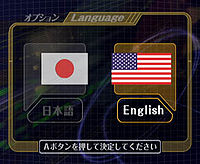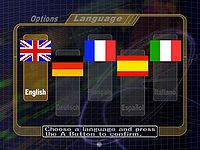Language
Language is an option found in the Options menu of Super Smash Bros. Melee and the PAL version of Super Smash Bros., and determined by system settings in Super Smash Bros. 4 and the PAL version of Super Smash Bros. Brawl. As the name suggests, the player can adjust the language of their copy of the game.
In Super Smash Bros.
In the European PAL version of SSB (uniquely, SSB has separate European and Australian PAL versions), the language can be set to English, French or German through an extra section on the options menu. When the player hovers over a menu item with the language set to either French or German, a white box with its corresponding translation will display at the bottom of the screen.
In Super Smash Bros. Melee
NTSC versions
In the NTSC versions of Melee, the player can switch between Japanese and American English for their languages. Changing the languages has little to no effect on actual gameplay; almost all changes in the game are cosmetic when languages are switched.
Interestingly, when the English language setting is active, the "Language" option is written in Japanese. The opposite occurs if Japanese is set as the language instead.
List of differences in the Japanese version versus the American English version
- Bowser and Jigglypuff are given their Japanese names of "Koopa" and "Purin" in Japanese. All Pokémon, when released, will also say their original names depending on the version.
- Ice Climbers has a caption of "Ice Climber"; in addition, the narrator refers to them as "Ice Climber" as well.
- Donkey Kong's caption in Japanese in spelled as "D. KONG"; in English, Donkey Kong's caption is "DK".
- The Collection mode will change depending on the language; a list of differences can be seen in the Collection article.
- Trophies will display what console the game was released for in Japanese; this indication doesn't appear in American English. Trophies are also referred to as "Figurines" in Japanese.
- Characters may or may not speak depending on the language. In American English, neither Falco nor Mewtwo speak, but in Japanese, the two speak in full sentences in some cases.
- The camera angle in the Home-Run Contest is more zoomed-in when the language is set to Japanese.
- All distances in the game are recorded in feet in American English, due to America's use of the U.S. Imperial System. All distances are recorded in metres in Japanese, as Japan uses the metric system.
- The latter is also the case with PAL versions.
- The announcer says different phrases in some of the game modes, which are covered in the respective article.
- Crowd chants are different in Japanese than they are in American English.
- The Sound Test features two kanji characters in place of the discs when set to Japanese; these characters also spin when music is played.
- There are various cosmetic changes to the menus. On the Character select screen, for instance, when set to Japanese, the "Ready to Fight!" banner says "Press Start/Pause", while in American English, it will simply say "Press Start".
- The lottery, in Japanese, will say "Get!" and "New Figure". In English, these messages will be replaced by "Got it!" and "A new trophy!" In addition, the Lottery also has a green "A" above the lever when the game is set to Japanese.
- The Motion-Sensor Bomb from Goldeneye reverts to its appearance in Perfect Dark as in the Japanese release of Melee, both in-game and its trophy.
PAL versions
In PAL versions of Melee, the player can choose between five different languages in the game, reflecting the multiple areas of the European Union. They are:
- English
- German
- French
- Spanish
- Italian
The quality of the European localization is questionable; while most of the "simple" text is translated, a majority of the game's text, notably of game modes and menu options, remain in English. Furthermore, despite the presence of the British flag on the English option, the text is unchanged compared to the NTSC's English language setting, and does not take into account for regional differences, such as the use of "color" over "colour".
Similar to the NTSC version, changing the language causes some minor changes in the game.
In Super Smash Bros. Brawl
NTSC Versions
Players no longer have the option to choose between Japanese and American English in Brawl.
PAL versions
In PAL versions of Brawl, the player can choose between five different languages, like in Melee. The choices remain the same, and like before, aspects of the game can change. However, the language cannot be changed in-game, as the language for Wii games is decided based on what language the console is set to.
Compared to Melee, all text is translated to the language of choice.
In Super Smash Bros. 4
NTSC version
The NTSC version can be set to English, French or Spanish. However, like the PAL version of Brawl, this is dependent on the console's set language.
PAL version
The PAL version now supports eight languages, with the additions being Dutch, Portuguese and Russian. As with Brawl, the language is dependent on the console's set language and cannot be changed in-game. While the five languages from Melee and Brawl continue to localize the announcer and a small number of character voices, the three new languages use the same voices as the PAL English version.
Trivia
- In non-English Western language versions of Brawl and SSB4, most characters retain their voices from the English version, with English or Japanese dialogue where applicable. Exceptions include most Pokémon characters (apart from Pikachu, Charizard, Mewtwo and a few Poké Ball Pokémon), the Wii Fit Trainers, and Sonic (in SSB4 only). This is due to the Pokémon anime and spinoff games, the Wii Fit series, and Sonic games (from Sonic Generations onwards) being dubbed into many languages, while the other represented series are either unvoiced or retain the English voices with translated text and subtitles. However, Fox, Falco and Ike still speak English, even though Star Fox 64 3D and Fire Emblem: Radiant Dawn were dubbed into multiple languages, and Cloud speaks Japanese even though most of his home series appearances were dubbed into English (with some dubbed in additional languages).
- In tournament play, some tournaments in non-English-speaking regions choose to set the game to English rather than the regional language, presumably due to English being the standard game language setting in national tournaments. For example, the "Master Hand" Melee tournament series in Japan uses the game's English language option.
| Super Smash Bros. Melee menu items | |
|---|---|
| Vs. Mode | Melee (Time · Stock · Coin Battle · Bonus · Team Battle) · Custom Rules · Special Melee · Tournament Mode · Names |
| 1-P Mode | Regular Match (Classic Mode · All-Star Mode · Adventure Mode) · Event Match · Stadium (Target Test · Home-Run Contest · Multi-Man Melee) · Training |
| Trophies | Gallery · Collection · Lottery |
| Options | Rumble · Sound · Screen Display · Language · Erase Data |
| Data | Snapshots · Melee Records · Sound Test · Archives (NTSC only) · How to Play (PAL only) |
| Unused | Debug menu · Debug sound test menu |
| Super Smash Bros. Brawl menu items | |
|---|---|
| Group | Brawl (Time · Stock · Coin Battle · Team Battle) · Rules · Special Brawl · Rotation · Tourney · Names |
| Solo | Classic · All-Star · Adventure Mode: The Subspace Emissary · Events · Stadium (Target Smash!! · Home-Run Contest · Multi-Man Brawl · Boss Battles) · Training |
| Wi-Fi | Spectator Mode · With Anyone · With Friends |
| Vault | Trophies & Stickers (Trophy Gallery · Trophy Hoard · Coin Launcher · Sticker Album · Sticker Center) · Stage Builder · Album · Challenges · Replays · Masterpieces · Chronicle |
| Options | Screen · Deflicker · Rumble · Controls · Sound · My Music · Erase Data |
| Data | Movies · Records (Group Records · Brawl Records · Notices) · Sound Test |


